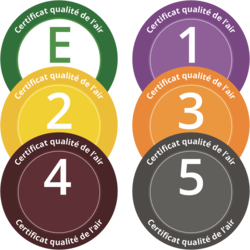Name of the environmental zone: Environmental zone Valence/Drôme ZPAd - France
Date of entry into effect of the zone: 27-11-2017
Type of environmental zone: temporary, weather-related air protection zone, active when pollution limits are exceeded
Not allowed to drive (temporarily): Vehicles without a badge and vehicles with insufficient badge class, depending on the level and duration of the air pollution peak.
Not allowed to drive (permanently): Information currently unavailable
Fines: 68-450 €
Area/extension of the environmental zone: The ZPAd zone covers theoretically the entire Department of Drôme. In case of pollution peak, a press release issued by the prefect will define the exact borders of the activated zone and announce the entry into force of the area. Possible affected highway in the department is the A7.
Contact of the environmental zone and exceptions: Information currently unavailable
Exemptions: Doctor, Fire brigade, Military, Police car, Customs, Snow plough, Public bus and Ambulance
Environmental zone ZPAd
Do I need stickers or registrations?
If there is a peak in air pollution and the ZPAd zone is activated, each affected vehicle requires a valid French environmental sticker (Certificat qualité de l'Air) to enter the low emission zone. Otherwise, a fine of between 68 euros and 375 euros is to be expected.
You can find out whether a ZPAd zone is active and which vignette is affected by the driving ban in our Green-Zones App.
What is a ZPAd zone?
ZPAd ("zone de protection de l'air départementale") are air protection zones that apply to an entire department. It is not possible to define in advance in which local areas within the ZPAd traffic restrictions will occur due to a peak in air pollution. In the event of a peak in air pollution, the respective initial decree provides for specific traffic restrictions, so that only then is the area within the department determined in a specific police decree, in which specific measures are then taken. In theory, even an entire department could be affected by a concrete measure, but this is relatively unlikely.
In any case, the prefect of the department is responsible for imposing driving bans where necessary (e.g. in one or more communes, on a motorway or within the entire department), based on data supplied to him by the regional air protection institute. The Certificat qualité de l'Air Vignette, which must be excluded from traffic, is also decided in these cases.
How do I recognize the low emission zone?
ZPAd zones are only activated temporarily. The size and dimensions of the zone are completely individual. This is determined by the respective prefect, depending on the intensity of air pollution. Therefore there are no special signs for ZPAd zones.
The situation is different for the ZFE zones. There, the beginning and the end of the environmental zones are marked with signs. This shows a red circle as prohibition sign with the remark "Zones à Circulation Restreinte" (Restricted Zone). Who exactly is allowed to enter or not is not indicated by the entry sign.
In our Green Zones App we have a detailed map of each low emission zone. So you can easily see the boundaries and avoid penalties.
Are there other low emission zones in France?
Yes, a lot of them. France has over 30 different environmental zones. These differ in ZFE (permanent), ZPA (temporary) and ZPAd (temporary département) zones.
In our Green Zones App we have gathered together all the low emission zones in Europe and presented them clearly.
Good to know...
All current driving bans and further information are available in our Green-Zones App.
Are night-time environmental zones coming?
The Berlin Green Party recently presented a proposal to equalise the traffic congestion in the capital. The idea is to shift delivery and commercial traffic to the night-time hours. According to Antje Kapek, transport spokesperson for the Greens, this proposal should help to ensure that delivery vehicles, refuse collection, care services and doctors get stuck less in congested and parked-up streets during the day. Low-noise and low-emission lorries could increasingly drive into cities at night and on special routes.
Bicycle instead of car - Paris in transition
A study by a public foundation has shown that more than one in ten journeys in Paris and the surrounding area are made by bicycle. This is a remarkable increase compared to 14 years ago, when less than one in thirty journeys were made by bike. Paris seems to have been endeavouring to change its transport policy for years. With more cycle paths and cycle lanes, fewer car parks and higher parking charges, the city is trying to promote cycling and reduce car traffic. But what does this mean for the existing low emission zone?



![[Translate to Englisch:]](https://www.green-zones.eu/fileadmin/_processed_/8/3/csm_screenshot_2024-04-18_125614_c7d9eca4a5.png)
![[Translate to Englisch:]](https://www.green-zones.eu/fileadmin/_processed_/2/0/csm_screenshot_2024-04-18_121908_5e1053efaf.png)